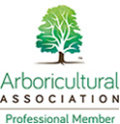Tree Health and Failure Risk Assessments
As discussed in my Trees and the Law blog, tree owners have legal responsibilites to ensure that potetial problems with their trees are checked by a 'competent person' to ensure that 'reasonably foreseeable' injury and loss is avoided. The tree owner may have spotted signs of abnormality, for example a fungal 'bracket' on the stem or around the roots, possibly combined with a lack of vigour, early leaf drop etc. These symptoms might be an indication that the tree's normal growth functions are being compromised as the living tissues on the outside of the tree (the sapwood) aren't able to transport water and nutrients to the leaves in the volume required.
Trees generally fail due to one of two scenarios - they die as a result of a problem in the vascular transport systems as mentioned above, or they fail biomechanically due to decay, often in the root anchorage systems or in the lower stem, resulting in 'windthrow'.
Colonisation by fungi is associated with both scenarios of tree failure, and there are many species of fungi 'of interest' to the arboricultural consultant (though many more live happily in association with trees and cause no harm whatsoever). The fungi which may be harmful to trees have different colonisation 'strategies', based on the area of the tree they populate, and the type of wood structure they 'digest'. It should be stressed that becasue a tree has a potentially harmful fungus, it's not necessarily a cause for concern, many can co-exist with trees for centuries as part of the latter's normal ageing (veteranization) processes. However, it's important to qualify this, so as discussed above, it's time to call in the experts.
Historically, we've had limited resources to assess what's going on inside a tree.The first port of call would be to test for hollowness using a nylon-headed sounding mallet as part of a Visual Tree Assessment (VTA). This is still part of the process, and reveals whether a hollow is present, but gives no information as to how hollow a tree is, and correspondingly, how safe it may be. Today, advances in technology give practitioners a range of tools to gain detailed insights as to the extent of decay, which in conjunction with 'Static Integrated Assessment' analysis provides the basis for accurate work prescriptions.
The first of these tools is Sonic Tomography, such as the PiCUS® system from IML used by Chaucer Landscape Management. This system relies on the impedance differences in the transmission of sound waves between sensors placed around the curcumference of the tree, the stem of which is accurately plotted using electronic calipers. Solid wood transmits sound faster than decayed wood, and the resulting 'tomogram' provides a visual representation of the impedance differences.
The 'value add' by the competent consultant is to analyse these results in conjunction with the tree. Impedance variances may indicate decay, but as the song says, "it aint necessarily so".Normal growth features such as small cracks (for example 'ring shakes') or bark inclusions (where bark folds are contained within the stem structure) distort sound waves and may provide the appearance of hollowing whereas the stem is perfectly sound.
This is why all PiCUS® tests I carry out are verified using another high-tech resourse, Resistograph drilling. The IML Resistograph Resi 400PD® is a very small diameter drill which measures both feed (thrust) force and tortional resistance to a depth of 400mm, providing an accurate readout of the wood density.
Where both PiCUS® and Resitograph testing indicates the presence of decay, the results must be analysed in conjunction with the whole tree to inform appropriate work prescriptions. Too often, trees are removed becasue this detailed analysis doesn't take place. Trees are described as having a 'Safety Factor' SF=(Load-bearing capacity)/(loads). The TreeCalc® software used by Chaucer Landscape Management provides a "Residual Safety Factor", building in the results of the PiCUS®/Resistograph testing into a computer model which then suggests the actions required to reduce risk to an aceptable level.
In many cases, it may be that despite extensive hollowing, no work is required. As mentioned above, hollowing is a normal part of many trees' ageing processes and as long as the progression of incipient (progressing) decay is monitored, the tree will be perfectly sound. This ongoing testing will also track whether the tree is producing 'reaction wood' - adaptive growth to provide biomecanical stress defences (trees are a lot cleverer than we give them credit for!). Alternatively, the stress loading on a compromised tree may be reduced to an acceptable level by making the crown smaller ( a 'crown reduction' carried out in accordance with BS3998 by a competent arborist). Sadly sometimes the results of this work are that tree removal is the only safe option, but with diligent testing and thorough results analysis I'm glad to say these cases are relatively rare, enabling us to retain trees which would have otherwise been condemned.


